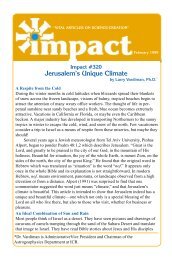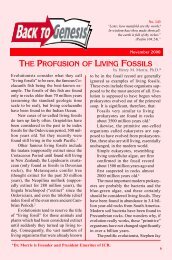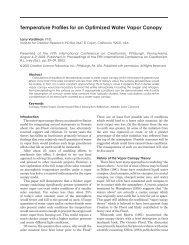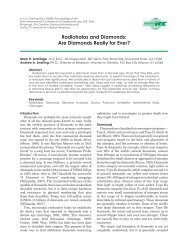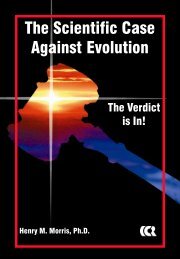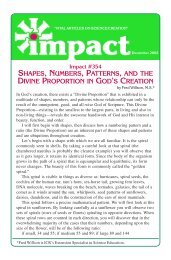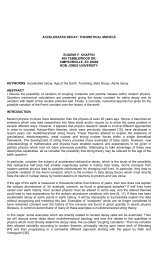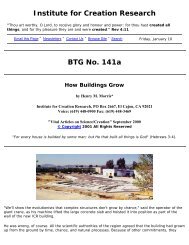radioisotopes and the age of the earth - Institute for Creation Research
radioisotopes and the age of the earth - Institute for Creation Research
radioisotopes and the age of the earth - Institute for Creation Research
Create successful ePaper yourself
Turn your PDF publications into a flip-book with our unique Google optimized e-Paper software.
Radiohalos – Dr. Andrew A. Snelling, PIThe significance <strong>of</strong> radiohalos is due to <strong>the</strong> fact <strong>the</strong>y represent a physical, integral historical record <strong>of</strong> <strong>the</strong>decay <strong>of</strong> <strong>radioisotopes</strong> in <strong>the</strong> radiocenters over a period <strong>of</strong> time as discussed by Snelling [17] <strong>and</strong>Snelling <strong>and</strong> Armit<strong>age</strong> [20]. The darkening <strong>of</strong> <strong>the</strong> minerals surrounding <strong>the</strong> radiocenters is caused bydam<strong>age</strong> to <strong>the</strong>ir crystal structure by alpha particles produced by nuclear decay. As part <strong>of</strong> a systematicef<strong>for</strong>t to investigate radiohalo occurrences in granitic rocks globally <strong>and</strong> throughout <strong>the</strong> geologic record,suitable samples have been collected from <strong>the</strong> La Posta (sou<strong>the</strong>rn Cali<strong>for</strong>nia), Stone Mountain (nearAtlanta, Georgia) <strong>and</strong> Cooma (sou<strong>the</strong>rn New South Wales, Australia) plutons.The biotite crystals in all <strong>the</strong>se granites contain abundant 238 U, 210 Po, <strong>and</strong> 214 Po radiohalos. Theoccurrence ratio is approximately five 210 Po radiohalos <strong>for</strong> every 214 Po <strong>and</strong> 238 U radiohalo, which occurroughly in equal numbers except in <strong>the</strong> Cooma pluton (see Fig. 4). While <strong>the</strong>se radiohalos arehomogeneously distributed throughout <strong>the</strong> mineralogically uni<strong>for</strong>m Stone Mountain pluton, <strong>the</strong>y arealmost exclusively concentrated in <strong>the</strong> muscovite-biotite granodiorite core <strong>of</strong> <strong>the</strong> La Posta pluton.Fur<strong>the</strong>rmore, <strong>the</strong>re are four to five times more <strong>of</strong> all <strong>the</strong>se radiohalos in <strong>the</strong> associated late-st<strong>age</strong>, IndianHills granite (sou<strong>the</strong>rn Cali<strong>for</strong>nia).Figure 4. Number <strong>of</strong> radiohalos vs. type <strong>and</strong> location.Hydro<strong>the</strong>rmal fluids are invariably concentrated in <strong>the</strong> last liquid phases during <strong>the</strong> rapid convectivecooling <strong>of</strong> granite plutons as discussed by Snelling <strong>and</strong> Woodmorappe [21], so this pattern <strong>of</strong> radiohalooccurrence in <strong>the</strong> La Posta pluton <strong>and</strong> Indian Hills granite strongly suggests that <strong>the</strong> Po radiohalos have<strong>for</strong>med as a result <strong>of</strong> late hydro<strong>the</strong>rmal fluid transport <strong>of</strong> Po <strong>radioisotopes</strong> locally within <strong>the</strong> biotite flakesseparating <strong>the</strong>m from <strong>the</strong>ir parent 238 U in <strong>the</strong> zircons. The Cooma granite was produced by partialmelting at <strong>the</strong> center <strong>of</strong> a regional metamorphic complex. Thus, this research has <strong>the</strong> potential todemonstrate that both <strong>the</strong> cooling <strong>of</strong> granite plutons <strong>and</strong> regional metamorphism occurred within weeksto months, not over millions <strong>of</strong> years, because <strong>of</strong> <strong>the</strong> short half-life <strong>of</strong> 218 Po. Radiohalo occurrences ino<strong>the</strong>r granitic plutons at many levels in <strong>the</strong> geologic record are also under continuing investigation.Isochron Discordance – Dr. Steven A. Austin, PIField observations, petrographic study, <strong>and</strong> geochemical analysis by Snelling et al. [22] indicate that a95-meter-thick sill in sharp contact with <strong>the</strong> intruded Hakatai shale near Bass Rapids in Gr<strong>and</strong> Canyonwas well mixed isotopically when emplaced. However, after intrusion, it segregated mineralogically <strong>and</strong>chemically by crystal settling. Such a condition <strong>of</strong> thorough isotopic mixing followed by rapid chemicalsegregation is ideally suited to test <strong>the</strong> assumptions that underlie whole-rock <strong>and</strong> mineral isochrondating. Both creationists <strong>and</strong> evolutionists should accept <strong>the</strong> well-mixed initial isotopic condition <strong>of</strong> <strong>the</strong>original magma body.



